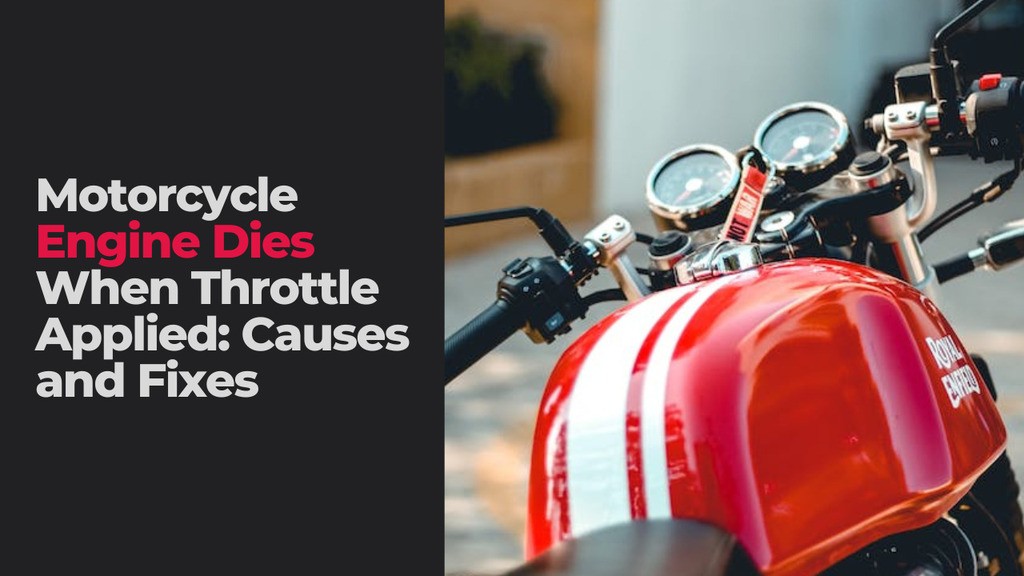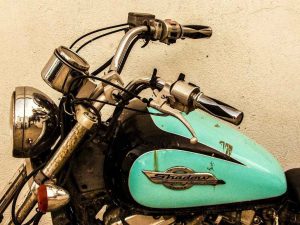Nothing is more frustrating than twisting the throttle on your motorcycle only to have the engine die on you. One moment you’re cruising down the road, the next you find yourself stranded on the side. What could be causing this puzzling problem?
There are several potential culprits that might have your engine cutting out just when you least expect it. We’ll take a look at some common causes for motorcycle engine dies when throttle applied, and provide some simple diagnostic steps to identify and fix the issue.
The Common Causes of Motorcycle Engine Dies When Throttle Applied
The main culprits for this unique problem could be:
- Air system problems
- Fuel system issues
- Carburetor issues
- Ignition problems
- Compression issues
Let’s discuss each of these possible issues in detail.
1. Air System Problems
There are several components in a motorcycle’s air system that can kill the engine during throttling.
a. Dirty air filter
The air filter does a big job. It catches dust and debris before air gets into your engine. But over time, all that junk clogs it up. Then when you twist the throttle, there isn’t enough clean air getting in for your motor to breathe properly.
Some signs it’s time for a clean or replacement: your bike feels like it’s losing power when you open it up. It might stutter or die at higher RPM. You also might notice it’s not as responsive when you roll on the throttle.
Checking the filter is easy. Just pop open the air box cover and pull it out. Hold it up to the light – if you can’t see daylight through it in lots of spots, time for some maintenance.
Cleaning is the cheaper option if it’s just dusty. Use air compressor or your gas station’s air hose to blow it out from the inside. Shake off loose dirt. Check for any tears while you’re at it.
If it’s really caked with muck, best to replace it. OEM filters are best but aftermarket boxes work in a pinch. Make sure the new one is good and tight in the airbox so no leaks occur.
A can of foam cleaner also does the trick for a deeper clean. Spray, scrub, rinse and let fully dry before reinstalling. Just be careful of getting foam in your engine.
Dirty filters are problematic. Your bike might run fine at idle but choke under load. So, do yourself a favor and check that air filter regularly. A clean one means your engine can breathe easy.
b. Intake leaks or vacuums leaks
Vacuum leaks can cause all sorts of issues if they aren’t sealed up tight. See, any holes or cracks in your intake tract messes with the precise air/fuel ratio your engine needs.
Some common leak spots are worn intake boots, ragged hoses and those cracked vacuum lines. Check them all over, especially where they connect at the carb, manifold, and cylinder head.
Here’s some ways to track down the culprit:
- Spray some carb cleaner or water around joints while the engine’s running. If you hear a change in rpm, you found it! Smoke machines from auto stores work too, just blow smoke into the intake and watch for wisps escaping.
- You can also do the light trick. Turn off all interior lights and have a buddy slowly crack open the gas cap. If the engine stutters, you’ve located a leak sucking in extra air.
Once you pin it down, repair depends on the part. Intake boots usually just need tightened clamps. Vacuums lines may need replacement. And don’t be shy about applying silicone sealer around manifolds for an airtight seal.
2. Fuel System Issues
If the airflow is looking good, it’s time to check what’s flowing through it. And that means taking a close look at your fuel, fuel filter, and fuel tank.
a. Contaminated or low quality fuel
Dirty fuel can certainly ruin your ride. Over time, water, dirt and even alcohol can separate out and wreak havoc on your system.
Some signs of bad gas? Rough idle, stuttering under throttle, and my personal favorite – when your machine suddenly smells like a liquor store! Yeah, you don’t want that vapor in your lungs.
Luckily, there’s some things we can do to prevent these issues:
- Only use reputable stations. It’s worth the drive for clean fuel.
- Try and burn through a tank within a month or two, so it doesn’t sit around.
- When storing, fill up the tank so no condensation forms. You can also try stabilizer, which helps fuel resist breakdown.
- Drain any carb bowls or slides before long parking.
If you’ve got dirty fuel issues, don’t just top it off – clean that system! Drain the gas and run some specialty cleaner through the whole line. Often just taking apart the bowls and soaking jets does the trick.
b. Clogged fuel filter
Another important player in your fuel system is the humble filter. This little guy does a big job keeping crud out of your precious fuel supply.
It’s usually tucked away downstream of the petcock or tank, so don’t forget to check it periodically. Start your inspection by locating it, whether it’s an in-line filter or the mesh type inside the petcock itself.
Gently remove the filter housing and have a peek inside. See any gunk buildup? Hold it up to the light – is it impossible to see through? If the answer is yes, it’s time for a change.
Replacement is simple, just make sure to prime the new filter of air after installing. Spin it between your fingers a few times before firing up that engine. This helps the fuel pump draw gas through faster.
Don’t forget to check any separate fuel line filters too, like on modern injection bikes. The principle is the same – a clean filter means crisp, consistent fuel delivery.
c. Problems with fuel tank vent
The fuel tank vent lets air into the tank as fuel heads out, so pressure inside stays balanced. Without proper ventilation, suction builds up in the lines that can mess with your fuel flow. So you want to make sure that vent passage is crystal clear.
First locate it – usually a small hole on the gas cap itself. Inspect by trying to see light through, or gently blowing into it. If you don’t feel much airflow, it’s likely plugged up.
Clogged vents are typically caused by gunk and moisture over time. Dirt or fluid buildup wants to creep into any tiny crevice!
The easiest fix is running a thin wire like from a coat hanger all the way through the vent opening. Twist it around to scrape away any debris inside. An old toothbrush works too for scrubbing.
Rinse well when you’re done so no residues remain. Make sure to dry fully before reinstalling the cap. While you’ve got it off, check the rubber sealing surface for splits too.
d. Water in fuel symptoms
Water can creep in fuel over time, especially in older bikes, and definitely needs to be addressed.
Some telltale signs water may be present – rough running, stalling when you rev it up, and that dreaded feel of vapor lock under acceleration. It’s sneaky too cuz it can seem fine at idle.
To properly diagnose, remove the drain plug from the carb float bowl and have a peek. You’ll clearly see any water sank to the bottom if there’s separation. It’s darker and more see-through than gas.
If you spot it, time to fully drain and dry out that whole system. Open up the bowl, pull the in-line filter if there is one, and let it drain overnight into a bucket. Shake fuel lines too just to be sure.
Next day, prime it all back up with fresh gas. But here’s the key – start her cold so any remaining moisture doesn’t get boiled into vapor by a hot engine. Let her warm naturally while running.
With any luck after a good flushing she’ll run like new. But play it safe – store with a full tank from now on or use a moisture absorber. Even a little water can hydrolock a piston, so keep your fuel dry!
3. Carburetor Issues
If the airflow and fuel flow check out, next stop is the carburetor. It mixes the air and fuel together correctly for your engine. So let’s dive in and check her jets, float settings, throttle cable, and choke.
a. Clogged pilot/main jets
Over time, varnish and gunk can build up inside the tiny passages of the pilot and main jets. This disrupts the precise fuel mixture needed. Symptoms include rough running, stalling, lack of power.
To inspect, you’ll need to pull off the top of the carb and gently remove the jets with a fine pick or needle. Place each in a small parts tray and examine closely with a bright light. Can you see all the way through each tiny hole?
If not, it’s time to deep clean! Soak jets in carb cleaner and then blow them out with compressed air. An old toothbrush is also handy for scrubbing. Pour some cleaner into the float bowl too for a good flush.
Once sparkling again inside, reassemble with care. Don’t overtighten so you don’t crack any tiny carb parts either. Prime the lines and she should fire right up.
Regular carb cleaning prevents stumbles and gives you crisp performance. It’s also the perfect time to inspect pilot screw and float level settings too. Tune ups keep our rides running at their best!
b. Improper float settings
The floats ensure the correct fuel level is maintained inside the bowl. They are adjustable by loosening a screw on the side of the needle jet. With the bike on its side, you can then properly check the alignment.
The float should sit perfectly parallel to the needle and seat. When you gently press down on it, there should be no friction or binding at all as it travels up and down.
If it’s sitting at an angle, the fuel level will be off – either too high or low. So don’t be afraid to lift off that jet and bend the float tab just a hair to square it up again.
Once aligned properly, take note of the specified measurement from the top of the float to the carb body. This marking ensures it’s not too high or low on its pivot after reinstalling.
It’s a small adjustment but crucial for precise metering. Improper float heights are a common cause of rough running or stumbling on acceleration.
c. Throttle cable/linkage problems
Carb tune ups wouldn’t be complete without checking the throttle cables. This vital linkage between your right hand twist and the carb puck is critical.
One way issues can crop up is from everyday vibration stressing cables over time. Or if you’ve noticed sluggish throttle response lately, corrosion could be building up inside the casing.
Inspect cables by fully twisting the grip and watching for any grinding, sticking or too much play at the linkage ends. Cables should slide smoothly without resistance the whole range of motion.
If excess wear is spotted, now’s the time to replace preventatively before a snap occurs on the road. New OEM cables last for years with simple, periodic inspections like these.
Also take note of the throttle linkage wiggling around on its pivot points too much or too little. Loose connections cause flabby throttle feel that no rider wants to deal with.
Tighten any loose fasteners or adjust the fittings. Give it all some fresh lube while you’re in there too.
d. Choke problems
The choke helps enrich your fuel mixture on those bone-chilling mornings.
First thing is finding it – often a lever on the left bar or twist grip. Give it a pull and listen close, you should hear a noticeable change in idle rpm as it opens.
Next, slowly twist the throttle and make sure it smoothly snaps shut after a second or two like it should. No sluggishness or sticking allowed for our early pioneers!
If you’re not hearing or feeling that choke doing its thing, time to lasso it in for a wrangle. Check the cable is sliding freely inside its casing first of all. Pull it out and squirt some juice lube inside the tunnel if needed to loosen any rust or grit buildup.
If the choke plate itself is stuck or warped, a soak in carb cleaner should do the trick. Just out it back together right before hitting the trail at dawn.
4. Ignition Issues
Is your motorcycle still not firing on all cylinders? It’s time to check the spark plugs, ignition timing, and ignition coil.
a. Spark plug issues
Spark plugs are crucial for getting a healthy ignition spark. Signs the plugs may need attention include misfires, sluggish acceleration, decreased fuel mileage. Sometimes they’ll even foul right up with oily or wet deposits.
Pull one out and examine closely. The porcelain should be white or light tan, not soaked black. Use a feeler gauge to check the gap – it should be within a few thousandths of what’s specified for your bike.
While you’ve got them out, you may as well replace if they’re worn looking or the gap is way off. New resistor plugs are cheap insurance for smooth combustion.
Go slow when threading plugs in so the ceramic doesn’t crack. Don’t overtighten – just snug is best. Then, start her up and listen for any remaining hiccups clear out with the fresh plugs.
b. Ignition timing adjustments
After plugs, let’s check the overall ignition timing issues. This ensures those spark plugs are firing at just the right moment.
For timing checks, you’ll need a dial-back or stroboscopic light. Follow your manual for specs on how far advanced or retarded your bike should be. Small adjustments can make a world of difference in performance.
c. Ignition coil/wiring problems
Coils ignite each plug via magnetic pulses, so inspect the coil pack or individual coils themselves. Look for cracks, burned areas or swelling – all signs of impending failure. Check wiring harnesses too.
Symptoms like missing on certain cylinders, rough idle, even lack of spark totally are clues something ain’t right. Trace wiring for any cuts, bare spots or corrosion building under connectors over time.
Replace coils or harness sections as needed. And never forget spark plug wires either – old brittle wires struggle to conduct that crucial spark energy effectively.
5. Compression Issues
When every other parts check out fine, inspect the compression system to fix the issue of motorcycle engine dies when throttle applied.
a. Worn piston rings
These crucial rings provide the sealing that builds compression. So let’s do a quick test.
First ensure the bike is fully warmed up to operating temp. Then, remove a spark plug and attach your compression gauge tightly in its hole. Crank the engine through a few revolutions and note the psi reading.
Reading within 10% or so of specs is usually fine. But significantly low pressure likely means worn or stuck rings aren’t doing their job. Over time exhaust gases and oil can burn or carbon up rings.
If readings check out too low, plan to pull the cylinder head and inspect for any glazing, cracks or excessive gap between ring and groove wall. Chances are replacement is needed by this point.
Be sure to install new rings with the correct end gap and orientation. You definitely don’t want to launch any shards of broken ring through that piston! New head gasket should also go in.
Checklist for Motorcycle Engine Dies When Throttle Applied
Do some basic maintenance tasks to prevent this issue from reappearing:
Maintenance tips
Start with the basics – always use the recommended grade of fuel and change oil regularly. Check all fluid levels often too like brake and coolant.
Inspect air filters every couple hundred miles in dusty conditions and clean or replace as needed. Never ignore leaks or seeps that can lead to bigger problems either.
Spark plugs should be gapped and checked yearly in normal riding. New plugs are cheap insurance for smooth combustion and performance.
Keep those carbs clean! At minimum do an annual deep cleaning to prevent jet clogs and idle issues. Inspect cables and linkage operation regularly too.
Give her a once over before long storage and apply protective coatings. Consider fuel additives to prevent moisture and varnish build up in the tank as well.
Catch small problems early. Nip that backfiring in the bud before it’s a blown head gasket. If something feels off, don’t ignore your instincts – get under there!
When to seek professional help
We all love saving a buck with DIY repairs. But sometimes it pays to call in the pros. Here are some signs it’s time to seek professional help:
- Major issues you can’t pin down – if basic checks don’t solve it, an expert can efficiently diagnose with special tools.
- Engine work – anything beyond basic maintenance like top end rebuilds requires specialty skills and precision.
- Electrical gremlins – advanced diagnostics may be needed to trace tricky electrical or computer problems.
- Specialty jobs – suspension work, brake overhauls, or drivetrain tasks benefit from the right lift and experience.
- Safety concerns – wonky brakes, failed forks, or severe wobbles indicate a mechanical inspection ASAP.
- Lack of proper tools – you can rent, but some jobs like dyno tuning just require a full shop.
- Time crunch – sometimes paying a mechanic is worth more family time or avoiding rushed DIY mistakes.
Don’t be afraid to admit when a task is over your head. An hour of shop labor is cheap insurance for piece of mind. And supporting local businesses keeps their doors open when you really need them.
FAQs About Dead Motorcycle Engine for Throttling
What are some common causes for an engine to die when giving it throttle?
Typical causes include a clogged air filter preventing enough air flow, fouled or faulty spark plugs preventing proper ignition, improperly adjusted carburetors not delivering the right fuel mixture, issues with ignition timing, vacuum leaks that disrupt airflow, and worn piston rings failing to build sufficient compression.
My bike runs fine at idle but dies when I open the throttle. How to test the fuel system?
Check for possible carburetor issues first by cleaning the jets and float bowl. If cleaning doesn’t help, you can test fuel delivery by loosening the drain screw at the bottom of the carb while applying throttle – fuel should flow freely. You can also inspect fuel filters and lines for obstructions.
What diagnostic steps should I take to check the spark plugs and ignition system?
Remove the plugs one by one and inspect them for fouling or worn electrodes. Check the gap and replace if needed. You can also do a spark test by grounding the plug against the engine while cranking to check for spark. Examine wires, coil and pickup for signs of damage too.
If compression and spark tests check out, what else could be the problem?
Consider checking ignition timing, testing the stator/CDI unit on electronic ignitions, and looking for airflow issues like vacuum leaks or a clogged airboot/filter. The ECU on fuel-injected bikes may also need reprogramming if mods were performed. Consult your manual’s troubleshooting guide.
How do I test engine compression without a gauge? What are some signs of low compression?
Pull a plug, crank the engine and feel for air pressure from the cylinder. It should be firm. Low pressure suggests worn rings or valves. Hard starting, smoke on decel, and oil consumption are also indicators. A proper gauge test is always best to confirm readings.




